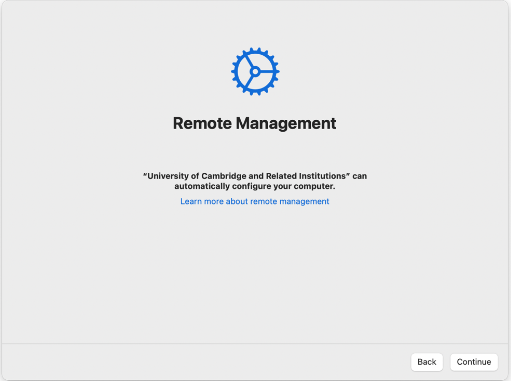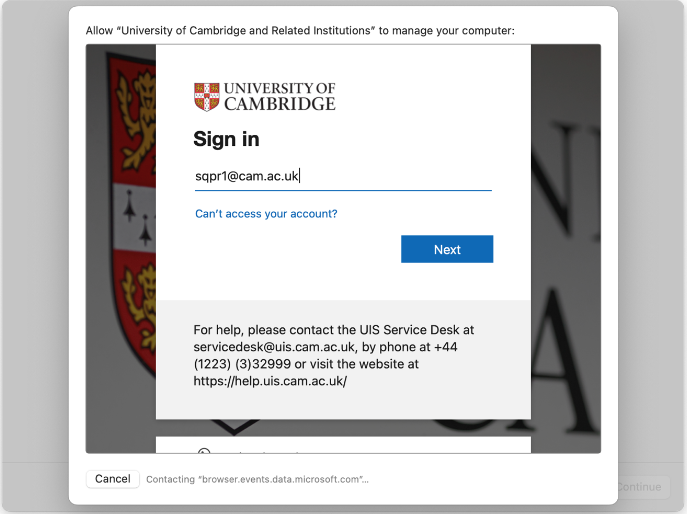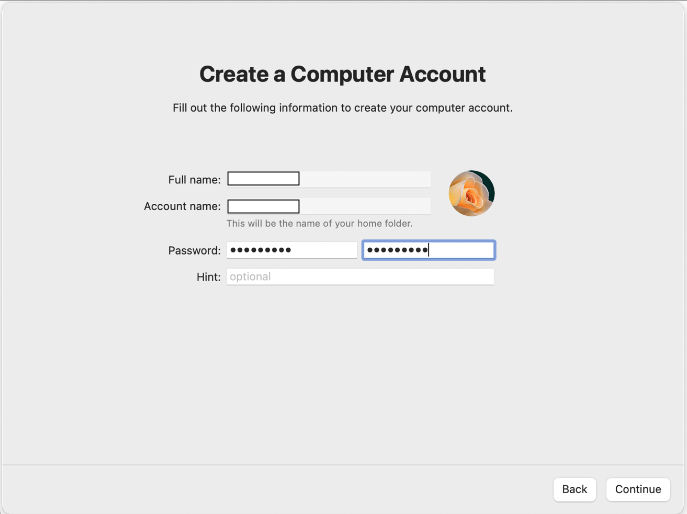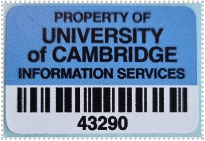This guide is aimed at new users of single-user configured UMD macOS devices. There are some simple steps to help you get set up as quickly as possible. During the initial setup you will connect the device to a wifi network and proceed though the Setup Assistant, configuring it to your desired state.
To setup up your UMD Mac you will need your @cam.ac.uk email address and University account password (formerly Raven).
Initial setup
Unpack your new device and power on.
Configure the device as follows:
Language
Select 'English (UK)'
Region
Select 'United Kingdom'
Accessibility
Choose any of the options that you require or select 'Not now'
Wifi
Choose and connect to your wifi network. You cannot connect to the eduroam wifi network or other 802.1X networks during the initial configuration as these are not supported. Please use a simple wifi configuration, for example, your home wifi network or the UniofCam-Guest network.
To use UniofCam-Guest follow these instructions:
- Find the AirPort ID (MAC address) for your device. It will be displayed on the back of the box.
- Follow the instructions on how to connect to the UniOfCam-Guest wifi network
- Unbox the Mac and power on
- When prompted join UniOfCam-Guest either using your email address or a social media account
- Continue through the setup process as prompted
Remote management
Your device will be enrolled into device management during the initial configuration. This ensures that the hardware remains under UIS control should the device be lost or stolen.
If you do not see this screen, please contact the Service Desk (servicedesk@uis.cam.ac.uk) providing the following information:
- Device Serial Number
- Asset tag number (if provided with device)
Authentication
Authenticate with your @cam.ac.uk email address and University account password (formerly Raven).
Account
The full name and account name fields will be pre-filled. Enter a password then select 'Continue'. The account will have local administrator rights.
Location
Select whether to enable Location Services or not. It is recommended to enable Location Services.
Touch ID
It is recommended to enable Touch ID. This allows you to authenticate and unlock the device using a fingerprint. Follow the guide to enable it.
Choose your look
Allows you to select either Light, Dark or Auto mode. Choose the look you prefer.
After initial setup
Disk encryption via FileVault
Disk encryption via FileVault ensures that your data always remains secure. The encryption key is encrypted and stored securely in an EU-hosted data centre.
The encryption prompt occurs at login and encryption is mandatory. It is strongly recommended to enable FileVault as soon as possible.
- Log out of your account then log back in
- When prompted to enable FileVault select 'Enable Now'
- Encryption will start and then you will be logged in to your account
Wifi
It’s recommended to set up eduroam for your device. Once setup you’ll have access to free and fast wifi across virtually all University buildings and some open spaces in Cambridge.
Application installation through Self Service
You can install applications through the Self Service app found in the Applications folder. Self Service allows the installation of different applications. Software not listed in the app can be requested by using this form.
VPN
To access some University resources when away from the University network you may need to use a VPN. There is a general purpose University VPN but some specific departmental resources may require the use of a Managed VPN.
Asset tag
Once you have completed the setup process and are happy the device is functioning correctly place the asset tag (if provided) on the bottom of the device. Please quote this asset tag number when requesting support.
Get help
If you have any problems or questions, please contact servicedesk@uis.cam.ac.uk making sure to include the asset tag number of the device.




